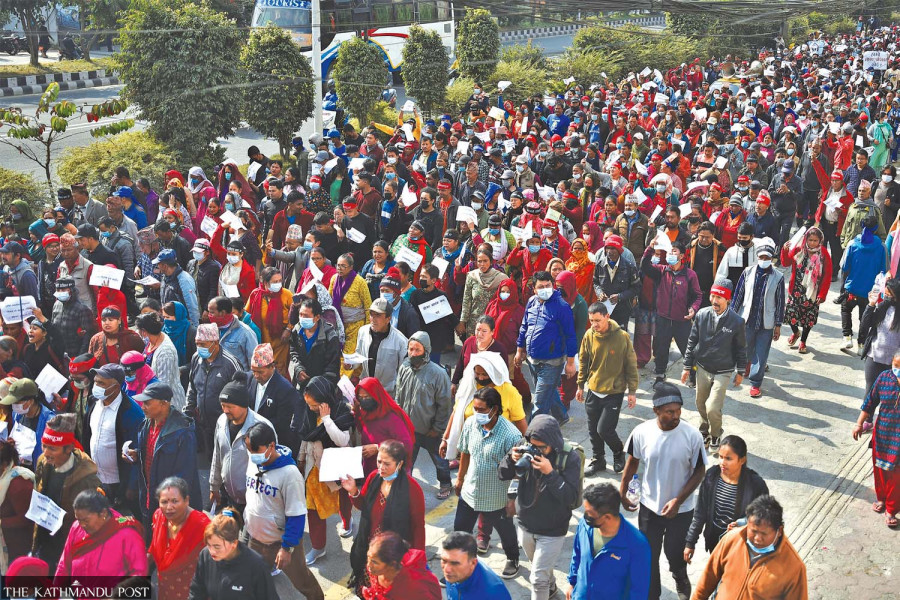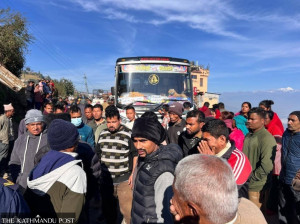Bagmati Province
Court ruling to boost KMC’s push to evict riverside squatters
Bagmati Civilisation officials say squatter hut demolition will resume with a simultaneous relocation plan.
Purushottam Poudel
In November 2022, after the High Powered Committee for Integrated Development of Bagmati Civilisation (HPCIDBC) issued an ultimatum to vacate riverside settlements, squatters living on the banks of the Bagmati River protested in Kathmandu against the ultimatum.
The committee, formed under the Ministry of Urban Development with the goal of making Bagmati a “pollution-free river”, had published a notice giving the squatters 10 days to vacate.
“Our ultimatum back then was ignored on the basis that the right to housing is a fundamental constitutional right,” says Uddhav Nepal, the information officer at the committee.
On November 28, the Kathmandu Metropolis deployed security forces to evict the squatters from Thapathali-based settlement. But the area turned into a battleground on the day as the squatters fiercely retaliated. The metropolis had to backtrack after over a dozen city police personnel were injured after the squatters attacked them with bricks, stones and sharp weapons.
Despite the failure to clear the area, the committee was able to ascertain the number of genuine squatters. “As per our data, there were 3,496 households on the Bagmati riverside,” says spokesperson Nepal.
When the HPCIDBC’s efforts to clear the riversides of Kathmandu Valley failed, a Land Commission was formed with a mandate to resolve the matter. However, due to frequent government changes, the commission could not work efficiently.
Now the authorities who were finding it difficult to remove the squatters have found a solid legal ground to do so.
The Supreme Court on Monday directed the authorities to clear the settlements along the banks of the Bagmati River and its tributaries in the Kathmandu Valley, but only after providing alternative housing for genuine squatters.
“The high powered committee will now discuss the full text of the Supreme Court and plan its next move,” Nepal told the Post. “Probably, we will soon start demolishing the huts and other structures along the riverbanks along with coming up with a proper relocation plan.”
A joint bench of Supreme Court Justice Ananda Mohan Bhattarai and Binod Sharma issued the order in order to control river pollution and remove the encroachment of riverside land.
Five persons including advocates Prakashmani Sharma, Narayan Belbase, and Rama Pant Kharel filed a petition on April 22, 2011, on behalf of the Janahit Samrakshan Manch (people’s rights protection forum), a non-profit. After hearing the petition, the top court issued a verdict on December 19 last year and its full text was made public on Monday evening.
The full text of the court has now cleared the way for the authorities to remove riverside settlements. “To identify the actual squatters and transfer them to the housing built in Ichangu Narayan, to build the required number of houses elsewhere and to facilitate the relocation of the actual squatters who do not want to move to those places… provide cash as immediate relief and remove the encroachment,” reads the Supreme Court order.
Last year, the mayor of Kathmandu Metropolitan City (KMC), Balendra Shah, who had tried to evict squatters from Bagmati riverbanks, had to backtrack after the Patan High Court issued an interim order against the KMC’s excavation of the Tukucha river.
Following a preliminary hearing on the writ petition on February 1, 2023, a joint bench of judges Mahesh Sharma Paudel and Rajya Lakshmi Bajracharya ruled in favour of property owners, declaring the KMC’s excavation of the Tukucha River illegal.
But Monday’s Supreme Court decision has in a way vindicated KMC Mayor Shah’s plan to remove squatter settlements from the riverbanks in Kathmandu.
After the verdict, the KMC will again consider removing the riverside squatter settlements, says one of its officials.
“Although nothing has been officially decided, clearing the riverside squatter settlements has been the KMC’s long-standing plan, which had been hindered by the court’s earlier decision,” the official told the Post on the condition of anonymity. “Now, the KMC will again push ahead with its earlier plan.”
When the KMC tried to remove the squatters, it had the support of the central government and its law enforcement bodies, but after the interim order of the High Court, KMC had to backtrack, says the KMC officer.
The squatters residing on the Bagmati river bank said they were not staying there by choice and would be happy to relocate if the government provides an alternative.
“We have for long been waiting for an appropriate government decision on our relocation. People living in squatter settlements will happily accept the government proposal,” says Min Kumar Magar, who resides on the Bagmati riverside settlement at Thapathali. “As citizens of this country, we should abide by its laws, so if the government has some proposal for our relocation, we are ready to accept it.”
However, the squatters earlier refused to move into the government-built housing units. In 2012, the government led by Prime Minister Baburam Bhattarai had built as many as 230 housing units at Ichangu Narayan area with a plan to relocate the squatters from the Bagmati corridor. But the squatters refused to go there citing accessibility issues, saying Ichangu Narayan was too far from the city.
Between 2010 and 2012, the Department of Urban Development and Building Construction purchased over eight ropani (0.4 hectares) of land in Ichangu Narayan, in ward 2 of the Nagarjun Municipality on the western rim of Kathmandu.
In May 2012, the Bhattarai-led government demolished 251 squatter huts in Thapathali by deploying over 1,000 security personnel. The government spent Rs230 million to build the housing units in Ichangu Narayan. The project proved to be a failure as nobody moved in.
From January 26, 2021 the apartment blocks have been partially used by the Manav Sewa Ashram, a non-profit that provides shelter for the homeless, and by a police unit.
“Those unwilling to reside in the property allotted to them must be removed from the encroached areas, and they should get necessary funds to shift to other places by respecting their rights to housing enshrined in Article 37 (1) of the Constitution of Nepal,” reads one of the points in the latest verdict. Every Nepali citizen has a constitutional right to proper housing.
But Magar, a representative of the squatters, claims they are unaware of plans to relocate them to Ichangu Narayan. “Nobody has come to us to discuss our relocation to Ichangu Narayan. If we receive a formal invitation, we will accept the proposal,” Magar further said. “Nobody likes to live in a vulnerable place like the riverside.”
However, Madan Tamang, 53, who claims to have lived in the squatter settlement at Tripureshwar for more than 40 years, says the Ichangu Narayan housing is not suitable for them.
“Two years back, some of our friends had visited the place, but found it inappropriate to live in,” Tamang told the Post. “If the government wants to relocate us, it should do so according to our needs.”




 7.12°C Kathmandu
7.12°C Kathmandu











